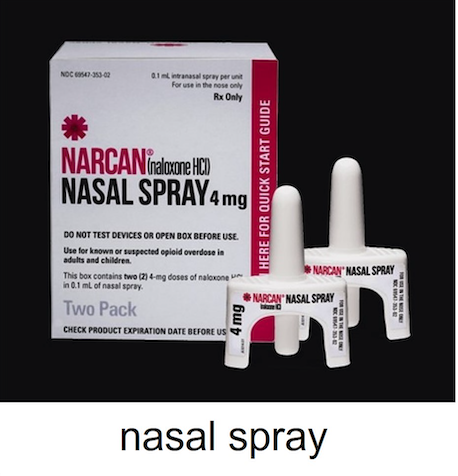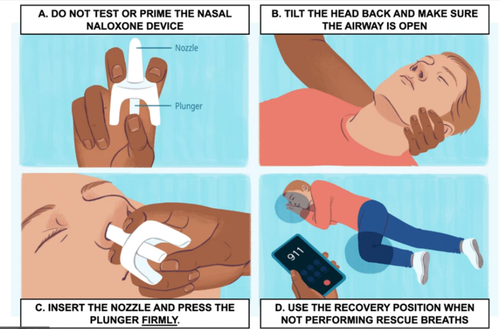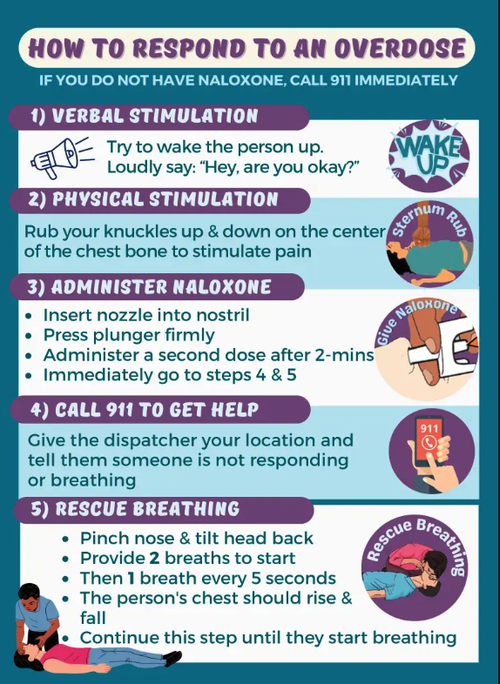Narcan (Naloxone) Available on Campus
What is Narcan?
Narcan (also known as Naloxone) is safe and easy to use, life-saving medication that works almost immediately to reverse opiate overdose including heroin, fentanyl and prescription opioid medications. It has few known adverse effects, no potential for abuse, and can be rapidly administered through a nasal spray in the nose.
When administered during an overdose, naloxone blocks the effect of opioids on the brain and restores breathing within two to eight minutes to prevent death.

Why use Narcan?
Narcan provides an extra layer of protection for those at a higher risk for overdose. Although most professional first responders and emergency departments carry narcan, they may not arrive in time to reverse an opioid overdose. Anyone can carry narcan, give it to someone having an overdose, and potentially save a life. Bystanders such as friends, family, non-health care providers and persons who use drugs can reverse an opioid overdose with naloxone.
How do you know if someone is having an opioid overdose?
- Small, constricted "pinpoint pupils"
- Falling asleep or losing consciousness
- Slow, weak or no breathing
- Choking or gurgling sounds
- Limp body
- Cold and/or clammy skin
- Discolored skin (especially in lips and nails)
How do I administer Narcan?
- Assess for a response
- Verbal stimulation - call their name loudly
- Shout “I’m going to Narcan you!” (verbal narcan) - if they say no, then ask them to sit up to show consciousness
- Physical stimulation - sternum rub: rub your knuckles up and down the center of their chest.
- If no response, proceed to Administration:
- Give naloxone - one spray into the nostril
- Set a time for 2-3 minutes to determine response
- During the 2-3 minutes, call 911 and share that you encountered someone not responding and not breathing, share your location. Then return your attention to the individual and assess if you should move to #3.
- Rescue breathing - after 2-3 minutes of no response or breathing
- Pinch their nose and lift the chin to open the airway
- Seal mouth to mouth and give 2 quick breaths
- Give 1 breath every 5 minutes
If no response and not breathing, repeat steps 2 and 3


What do after I administer Narcan?
Narcan often works immediately. But depending on the individual's size and use history, they may need more than 1 or 2 applications. If the person does not recover quickly you may need to perform other life-saving strategies such as Hands-Only CPR(link is external) and rescue breathing(link is external). Naloxone’s effect lasts for about 30 to 90 minutes in the body. If the narcan wears off before the effects of the opioids wear off, the person might go into an overdose again. For this reason, it is always very important to call emergency medical assistance.
After you administer narcan, do not leave the individual unattended until you can transfer their care to a medical professional. Ensure that you complete a injury report and notify public safety.
When people wake up from narcan, be kind and calm. They are more likely to be embarrassed.
Seek care for yourself as well. EAP resources are available.
Where are narcans on campus?
- Residential halls (Founders & Blattner)
- 80 Carolina, 2nd floor administration office
- Public Safety Offices
- Resource Library
Who administers Narcan?
Narcan is available on campus to support the reduction in opioids overdose in our community. Public safety, residential education staff and studio operations managers are lead administrators. Bystanders can follow the Good Samaritan Law and AB 635.
What do I do if I may have partaken in illegal substances but want to help a friend?
Feel free to reference CCA Code of Conduct - Amnesty Policy.
What resources are available?
- CA Public Health Department - Naloxone
- What You Need to Know About Naloxone
- How and When to Use Naloxone for an Opioid Overdose
- Opioid and substance use prevention resources for young adults
- Learn how to help reduce stigma against people who use drugs
Trainings:
- How to Use Narcan with the DOPE Project
- Administering Naloxone
- San Francisco Public Health- how to administer Narcan
Questions about CCA Narcan Policy? Feel free to reach out to hr@cca.edu